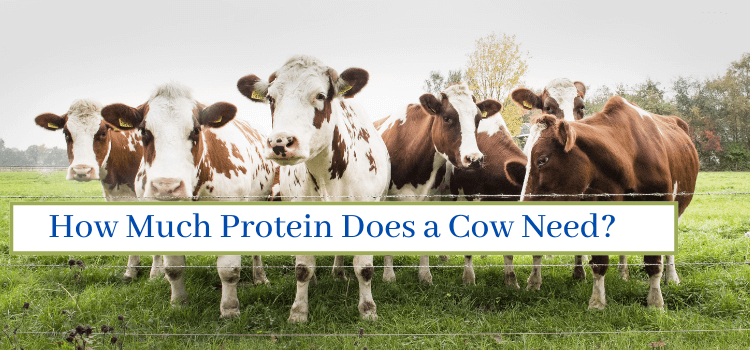If you want to make sure that your cows are gaining the best possible amount of protein, it’s important to learn how much they need. There are several different factors that go into determining how much a cow needs to stay healthy. This includes the type of feed you feed, how the cow is pregnant, how the cow is lactating, and how the cows live.
Nutritional requirements of a cow herd
A cow herd needs to meet its nutrient requirements in order to maintain healthy conditions, grow, and produce milk. These requirements are determined by a number of factors including age, stage of production, body weight, sex, and environmental conditions.

Nutrients required by a beef herd are primarily derived from harvested or grazed forage. However, there are also other supplementation strategies that can be used to ensure the nutritional needs of a herd.
One of the most important nutritional considerations for any herd is protein. Cows require a certain amount of crude protein to support placental growth and recovery of lean body tissue.
Protein is a type of dietary substance that includes amino acids, nucleic acids, dipeptides, and other nitrogen-containing compounds. It is typically measured in feedstuffs as crude protein.
There is a large concentration of protein in milk. Therefore, a high-quality colostrum is crucial to the production of high-quality heifer milk.
Protein requirements increase in the last two months of gestation. The demand for protein is also increased by the need to sustain fetal growth.
During lactation, nutrient requirements change even more. This is due to the increased metabolic demands on the body tissues. Although some nutrients can be stored in the cow’s body, others need to be ingested from the diet.
Water is another important nutrient for the body. Forage, feedstuffs, and feces contain water. Some of the functions of water in the body include temperature regulation, digestion, reproduction, and expulsion.
Water deficiency can lead to impaired performance and disease. Deficiency can also reduce cattle’s ability to produce milk and calve.
In addition, a lack of water can cause a cow to lag behind its peers in performance. Water is important for maintaining the optimum body temperature, as well as regulating the amount of nutrients in the body.
Pregnancy
The nutrient requirements of pregnant beef cows are different than those of non-pregnant cattle. During the first trimester of pregnancy, a cow needs 7% to 9% of its body weight as protein dry matter, while the second and third trimesters require up to 11%.
Protein supplementation during pregnancy results in improved fetal growth and increased offspring performance. It also has carryover effects on the pattern of intake.
Several mechanisms have been identified to generate responses, which can increase muscle growth in cattle progenies. These include energy metabolic pathways in the liver, mRNA expression of membrane transporters, and digestion enzyme activity.
Poor nutrition during the prenatal period can result in decreased colostrum quality, low birth weight, and reduced performance in lactation. Pregnant cows should be in good body condition at calving, and their nutrient requirements will rise during the late gestation period.
A meta-analysis investigated the effects of crude protein (CP), crude fat (CFA), and energy levels on pregnant beef cows. The results showed a relationship between crude protein, fat thickness, and loin eye area.
Mammals are born with a predetermined number of muscle cells. Hypertrophic processes are involved in determining the size of these cells. However, the amount of growth depends on the dietary protein and fat intake of the mother.
Cows in good condition will require less feed to maintain body heat during the winter. On the other hand, thin cows have higher nutrient needs. In spring-calving herds, the nutritional demands of pregnant cows and heifers are higher than in the fall. They need more protein and grain.
During the last three months of gestation, a fetus grows by approximately 75%. It builds blood, bone structure, and internal organs.
Late gestation and lactation
Late gestation and lactation require higher levels of protein, energy, and other nutrients. Depending on the breed of cow, requirements are about 25 percent greater than during the first eight weeks of lactation. These nutrient demands are not met in some cases, resulting in poor breeding and reproductive performance and reduced productivity.
Protein supplementation of pregnant beef cows fed a low-quality forage diet resulted in increased offspring performance. However, carryover effects on intake pattern may affect offspring intake and digestibility.
Maternal nutrition during gestation may also affect offspring performance through changes in nutrient use capacity. The mass of several organs and digestive enzyme activity may also be affected by nutritional conditions.
Nutritional disturbances during intrauterine development are known to affect nutrient digestion and the mRNA expression of membrane transporters. In turn, these changes may contribute to compensatory responses on nutrient digestibility and offspring performance.
A study assessed the effect of protein supplementation on various parameters in zebu beef cows. The results indicated that CON cows had higher total intakes and CP, DM and TDN consumption than RES cows during late and mid-gestation.
PKM and PPARG expression in calves was greater than in controls. Similarly, urinary 3-MH and urinary 3-MH by day did not differ among treatments.
Feed intake and daily refusals were collected for further analysis. Heifers were housed in individual pens with rubber mats and were cleaned daily. Until 7 d after parturition, they were maintained in straw. On day 8 of lactation, they were moved to outdoor pens.
During the postpartum period, all heifers were fed the same common lactation diet formulated to meet CNCPS 6.5 lactation requirements. One heifer became too aggressive after calving and was removed from the experiment.
Low-quality forages reduce protein intake
If you feed a forage-based diet to your cattle, it’s important to know how much protein you’re feeding your animals. Protein is a critical component of the nervous system, muscles, and connective tissues. It is also needed for reproduction.
During the early spring and late summer months, grass and legumes can provide up to 20% crude protein. However, as the harvest season approaches, the quality of forages is affected. In addition to the quality of the plants themselves, the technique used for harvesting can also affect the nutritional value of forage.
Low-quality forages can reduce a cow’s energy and protein intake. This can affect a number of aspects of your herd’s performance. Using a supplement can help your cattle get the nutrients they need. Depending on your cattle’s age, growth rate, and reproductive status, you may need to bypass the rumen and feed the animal a high-protein supplement.
To determine whether your cows are getting enough protein, you can use forage quality testing. This can be especially helpful if you feed your herd during the winter. The mineral content of forages is different depending on the plant and soil type.
When the forage is mature, it has a greater level of NDF, which is a measure of the plant’s digestibility. High levels of NDF indicate poor digestibility. Therefore, cattle should be fed only when the forage is high in digestibility.
Grass and legumes can be high in calcium. However, they may be low in other minerals. Feeding a forage-based diet with an adequate amount of calcium and other minerals can ensure your herd’s optimal health.
Many researchers have studied the effect of forage quality on animal performance and reproduction. For instance, a study by Dr. Cheryl Waldner of the Western College of Veterinary Medicine in Montana found that a diet that included both a forage and a high-protein supplement resulted in higher body weights and a more efficient metabolic CO2 emissions.
Feeding a high-protein cube
Using a high-protein cube to feed a cow can have positive effects on a cow’s health and productivity. These cubes are designed to be fed to beef cattle on dry winter forages. They are easy for the animal to consume and help maintain weight.
High-protein cubes come in various sizes and are a good option for maintaining a cow’s weight. The MFM 34% Hi-Energy Cube, for example, is a three-quarter-inch cube that offers a modest 5.5% fat content. It provides additional energy, along with vitamins and minerals.
In addition to providing protein, a high-protein cube can also improve the digestibility of forage. This can be especially helpful for thin, dry mature cows. Adding one to two pounds of this supplement daily should do the trick.
A study conducted by researchers from New Mexico State University found that infrequent delivery of a high-protein supplement did not significantly decrease heifer performance. Moreover, infrequent delivery reduced transportation costs by 60%.
If you are interested in improving the performance of your cows, then it is a good idea to understand the different types of supplements available. While alfalfa hay for sale is often the cheapest option, there are other nutrient-packed products you can consider.
Dried distillers grain is a good high-protein supplement. This is a byproduct of the ethanol industry that tests at 28-30% crude protein. However, it is relatively expensive per ton. For a cost-effective alternative, cottonseed meals can provide a similar amount of escape protein.
Another excellent supplemental forage is grain byproducts. Grain byproducts are low in starch, so they are ideal for improving forage intake. Some types of corn gluten meal are comparable to cottonseed meals.






Leave a Reply